Empowering Users: A Report on Healthcare Policies and Patient Rights
VerifiedAdded on 2020/01/15
|15
|4505
|153
Report
AI Summary
This report delves into the concept of user empowerment within the healthcare domain, examining its multifaceted aspects and implications. It begins by analyzing the influence of current legislation, such as the Health and Social Care Act, the Mental Health Act, the Care Act, and the Disability Discrimination Act, along with sector skills standards, on organizational policies and practices. The report then explores effective communication strategies between care workers and individuals, particularly those with disabilities, emphasizing the use of verbal and non-verbal communication techniques. Furthermore, it investigates factors contributing to the loss of independence, non-participation, and social exclusion, using case studies to illustrate these challenges. The report also addresses the maximization of patient rights through the development of supportive policies and practices within healthcare organizations. Finally, it examines ethical considerations in managing patient care, particularly in situations involving conflicting needs and safety concerns, such as the case of Mr. Harry with bipolar disorder. The report concludes by summarizing the key findings and recommendations for enhancing user empowerment in healthcare settings.
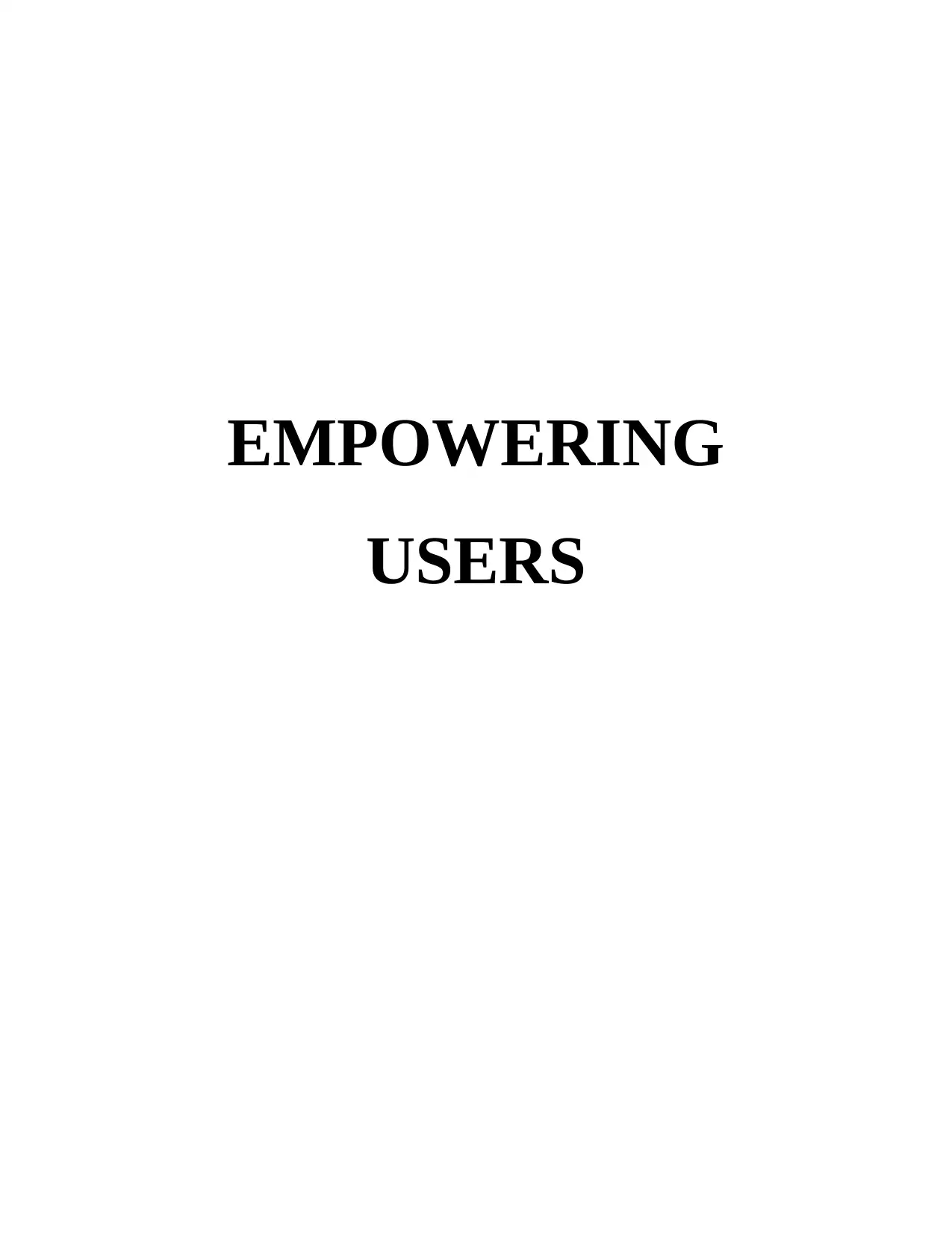
EMPOWERING
USERS
USERS
Paraphrase This Document
Need a fresh take? Get an instant paraphrase of this document with our AI Paraphraser
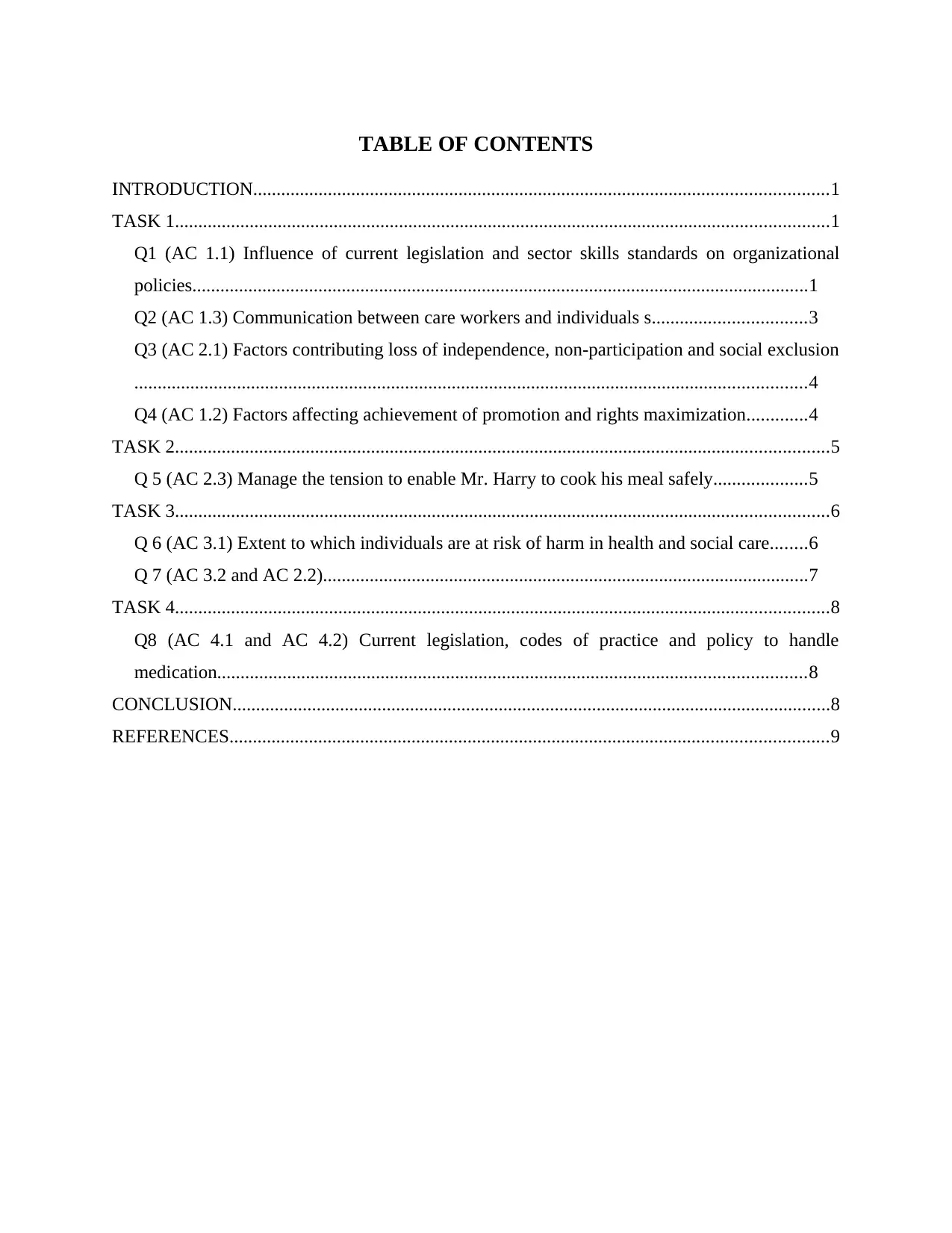
TABLE OF CONTENTS
INTRODUCTION...........................................................................................................................1
TASK 1............................................................................................................................................1
Q1 (AC 1.1) Influence of current legislation and sector skills standards on organizational
policies....................................................................................................................................1
Q2 (AC 1.3) Communication between care workers and individuals s.................................3
Q3 (AC 2.1) Factors contributing loss of independence, non-participation and social exclusion
................................................................................................................................................4
Q4 (AC 1.2) Factors affecting achievement of promotion and rights maximization.............4
TASK 2............................................................................................................................................5
Q 5 (AC 2.3) Manage the tension to enable Mr. Harry to cook his meal safely....................5
TASK 3............................................................................................................................................6
Q 6 (AC 3.1) Extent to which individuals are at risk of harm in health and social care........6
Q 7 (AC 3.2 and AC 2.2)........................................................................................................7
TASK 4............................................................................................................................................8
Q8 (AC 4.1 and AC 4.2) Current legislation, codes of practice and policy to handle
medication..............................................................................................................................8
CONCLUSION................................................................................................................................8
REFERENCES................................................................................................................................9
INTRODUCTION...........................................................................................................................1
TASK 1............................................................................................................................................1
Q1 (AC 1.1) Influence of current legislation and sector skills standards on organizational
policies....................................................................................................................................1
Q2 (AC 1.3) Communication between care workers and individuals s.................................3
Q3 (AC 2.1) Factors contributing loss of independence, non-participation and social exclusion
................................................................................................................................................4
Q4 (AC 1.2) Factors affecting achievement of promotion and rights maximization.............4
TASK 2............................................................................................................................................5
Q 5 (AC 2.3) Manage the tension to enable Mr. Harry to cook his meal safely....................5
TASK 3............................................................................................................................................6
Q 6 (AC 3.1) Extent to which individuals are at risk of harm in health and social care........6
Q 7 (AC 3.2 and AC 2.2)........................................................................................................7
TASK 4............................................................................................................................................8
Q8 (AC 4.1 and AC 4.2) Current legislation, codes of practice and policy to handle
medication..............................................................................................................................8
CONCLUSION................................................................................................................................8
REFERENCES................................................................................................................................9
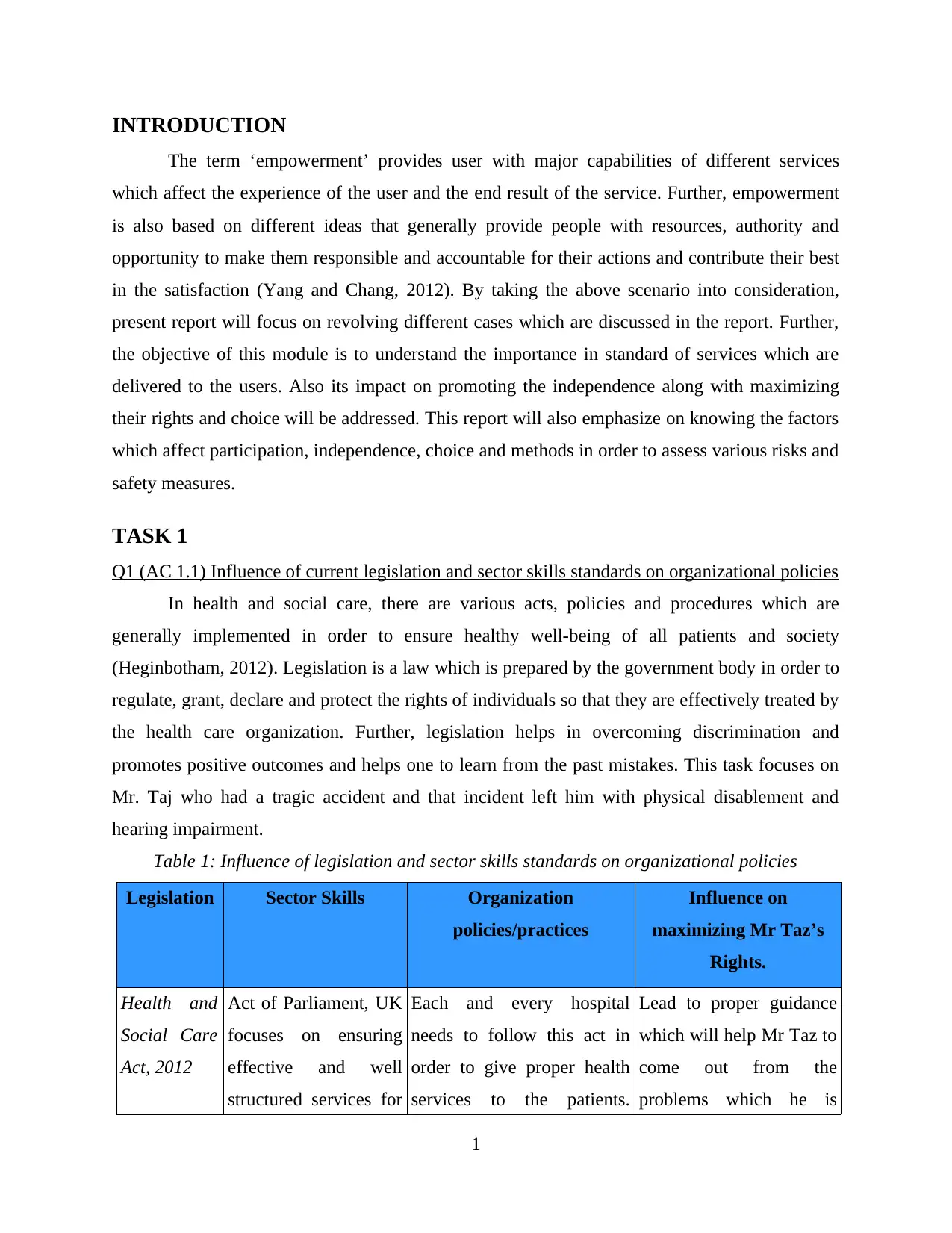
INTRODUCTION
The term ‘empowerment’ provides user with major capabilities of different services
which affect the experience of the user and the end result of the service. Further, empowerment
is also based on different ideas that generally provide people with resources, authority and
opportunity to make them responsible and accountable for their actions and contribute their best
in the satisfaction (Yang and Chang, 2012). By taking the above scenario into consideration,
present report will focus on revolving different cases which are discussed in the report. Further,
the objective of this module is to understand the importance in standard of services which are
delivered to the users. Also its impact on promoting the independence along with maximizing
their rights and choice will be addressed. This report will also emphasize on knowing the factors
which affect participation, independence, choice and methods in order to assess various risks and
safety measures.
TASK 1
Q1 (AC 1.1) Influence of current legislation and sector skills standards on organizational policies
In health and social care, there are various acts, policies and procedures which are
generally implemented in order to ensure healthy well-being of all patients and society
(Heginbotham, 2012). Legislation is a law which is prepared by the government body in order to
regulate, grant, declare and protect the rights of individuals so that they are effectively treated by
the health care organization. Further, legislation helps in overcoming discrimination and
promotes positive outcomes and helps one to learn from the past mistakes. This task focuses on
Mr. Taj who had a tragic accident and that incident left him with physical disablement and
hearing impairment.
Table 1: Influence of legislation and sector skills standards on organizational policies
Legislation Sector Skills Organization
policies/practices
Influence on
maximizing Mr Taz’s
Rights.
Health and
Social Care
Act, 2012
Act of Parliament, UK
focuses on ensuring
effective and well
structured services for
Each and every hospital
needs to follow this act in
order to give proper health
services to the patients.
Lead to proper guidance
which will help Mr Taz to
come out from the
problems which he is
1
The term ‘empowerment’ provides user with major capabilities of different services
which affect the experience of the user and the end result of the service. Further, empowerment
is also based on different ideas that generally provide people with resources, authority and
opportunity to make them responsible and accountable for their actions and contribute their best
in the satisfaction (Yang and Chang, 2012). By taking the above scenario into consideration,
present report will focus on revolving different cases which are discussed in the report. Further,
the objective of this module is to understand the importance in standard of services which are
delivered to the users. Also its impact on promoting the independence along with maximizing
their rights and choice will be addressed. This report will also emphasize on knowing the factors
which affect participation, independence, choice and methods in order to assess various risks and
safety measures.
TASK 1
Q1 (AC 1.1) Influence of current legislation and sector skills standards on organizational policies
In health and social care, there are various acts, policies and procedures which are
generally implemented in order to ensure healthy well-being of all patients and society
(Heginbotham, 2012). Legislation is a law which is prepared by the government body in order to
regulate, grant, declare and protect the rights of individuals so that they are effectively treated by
the health care organization. Further, legislation helps in overcoming discrimination and
promotes positive outcomes and helps one to learn from the past mistakes. This task focuses on
Mr. Taj who had a tragic accident and that incident left him with physical disablement and
hearing impairment.
Table 1: Influence of legislation and sector skills standards on organizational policies
Legislation Sector Skills Organization
policies/practices
Influence on
maximizing Mr Taz’s
Rights.
Health and
Social Care
Act, 2012
Act of Parliament, UK
focuses on ensuring
effective and well
structured services for
Each and every hospital
needs to follow this act in
order to give proper health
services to the patients.
Lead to proper guidance
which will help Mr Taz to
come out from the
problems which he is
1
⊘ This is a preview!⊘
Do you want full access?
Subscribe today to unlock all pages.

Trusted by 1+ million students worldwide
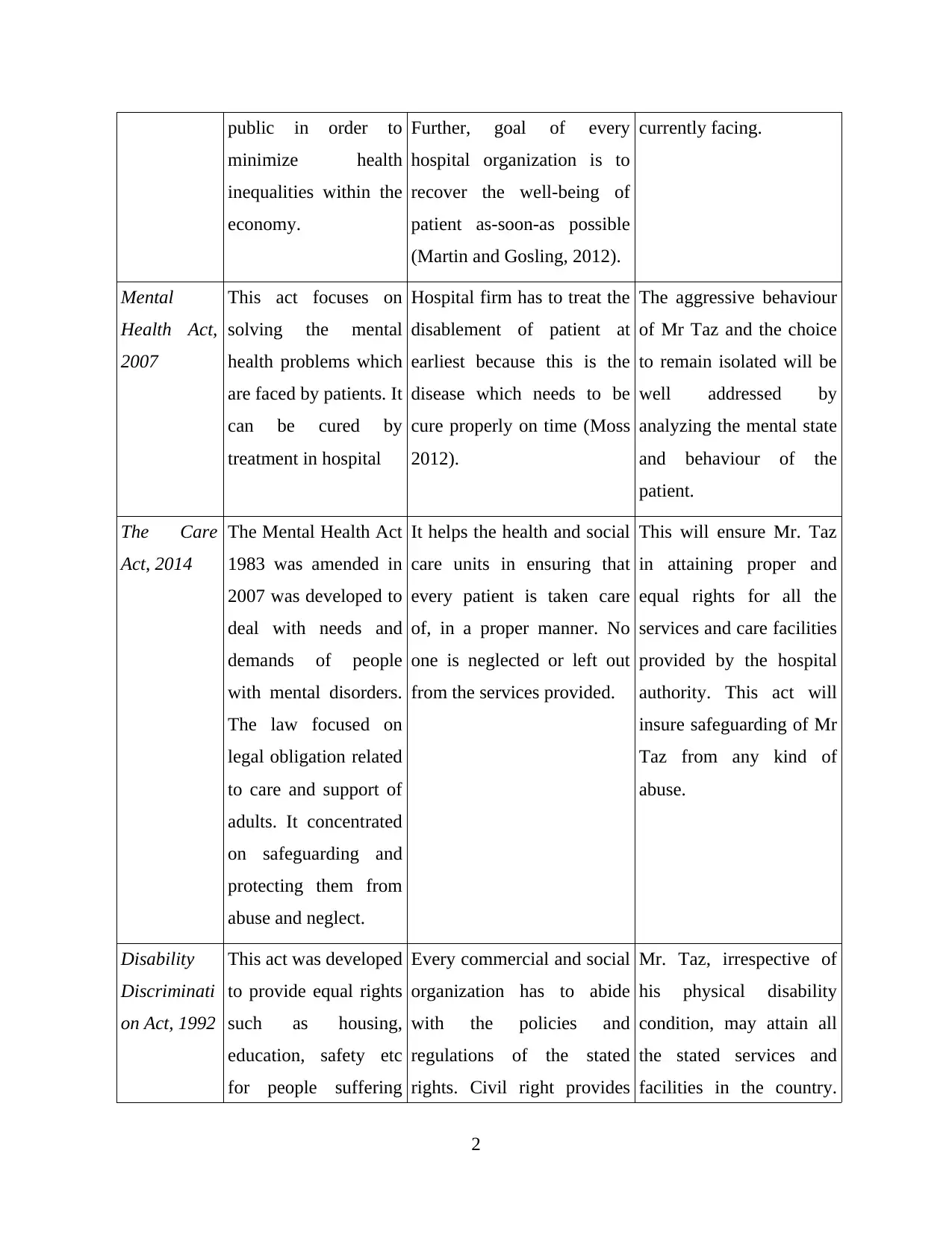
public in order to
minimize health
inequalities within the
economy.
Further, goal of every
hospital organization is to
recover the well-being of
patient as-soon-as possible
(Martin and Gosling, 2012).
currently facing.
Mental
Health Act,
2007
This act focuses on
solving the mental
health problems which
are faced by patients. It
can be cured by
treatment in hospital
Hospital firm has to treat the
disablement of patient at
earliest because this is the
disease which needs to be
cure properly on time (Moss
2012).
The aggressive behaviour
of Mr Taz and the choice
to remain isolated will be
well addressed by
analyzing the mental state
and behaviour of the
patient.
The Care
Act, 2014
The Mental Health Act
1983 was amended in
2007 was developed to
deal with needs and
demands of people
with mental disorders.
The law focused on
legal obligation related
to care and support of
adults. It concentrated
on safeguarding and
protecting them from
abuse and neglect.
It helps the health and social
care units in ensuring that
every patient is taken care
of, in a proper manner. No
one is neglected or left out
from the services provided.
This will ensure Mr. Taz
in attaining proper and
equal rights for all the
services and care facilities
provided by the hospital
authority. This act will
insure safeguarding of Mr
Taz from any kind of
abuse.
Disability
Discriminati
on Act, 1992
This act was developed
to provide equal rights
such as housing,
education, safety etc
for people suffering
Every commercial and social
organization has to abide
with the policies and
regulations of the stated
rights. Civil right provides
Mr. Taz, irrespective of
his physical disability
condition, may attain all
the stated services and
facilities in the country.
2
minimize health
inequalities within the
economy.
Further, goal of every
hospital organization is to
recover the well-being of
patient as-soon-as possible
(Martin and Gosling, 2012).
currently facing.
Mental
Health Act,
2007
This act focuses on
solving the mental
health problems which
are faced by patients. It
can be cured by
treatment in hospital
Hospital firm has to treat the
disablement of patient at
earliest because this is the
disease which needs to be
cure properly on time (Moss
2012).
The aggressive behaviour
of Mr Taz and the choice
to remain isolated will be
well addressed by
analyzing the mental state
and behaviour of the
patient.
The Care
Act, 2014
The Mental Health Act
1983 was amended in
2007 was developed to
deal with needs and
demands of people
with mental disorders.
The law focused on
legal obligation related
to care and support of
adults. It concentrated
on safeguarding and
protecting them from
abuse and neglect.
It helps the health and social
care units in ensuring that
every patient is taken care
of, in a proper manner. No
one is neglected or left out
from the services provided.
This will ensure Mr. Taz
in attaining proper and
equal rights for all the
services and care facilities
provided by the hospital
authority. This act will
insure safeguarding of Mr
Taz from any kind of
abuse.
Disability
Discriminati
on Act, 1992
This act was developed
to provide equal rights
such as housing,
education, safety etc
for people suffering
Every commercial and social
organization has to abide
with the policies and
regulations of the stated
rights. Civil right provides
Mr. Taz, irrespective of
his physical disability
condition, may attain all
the stated services and
facilities in the country.
2
Paraphrase This Document
Need a fresh take? Get an instant paraphrase of this document with our AI Paraphraser
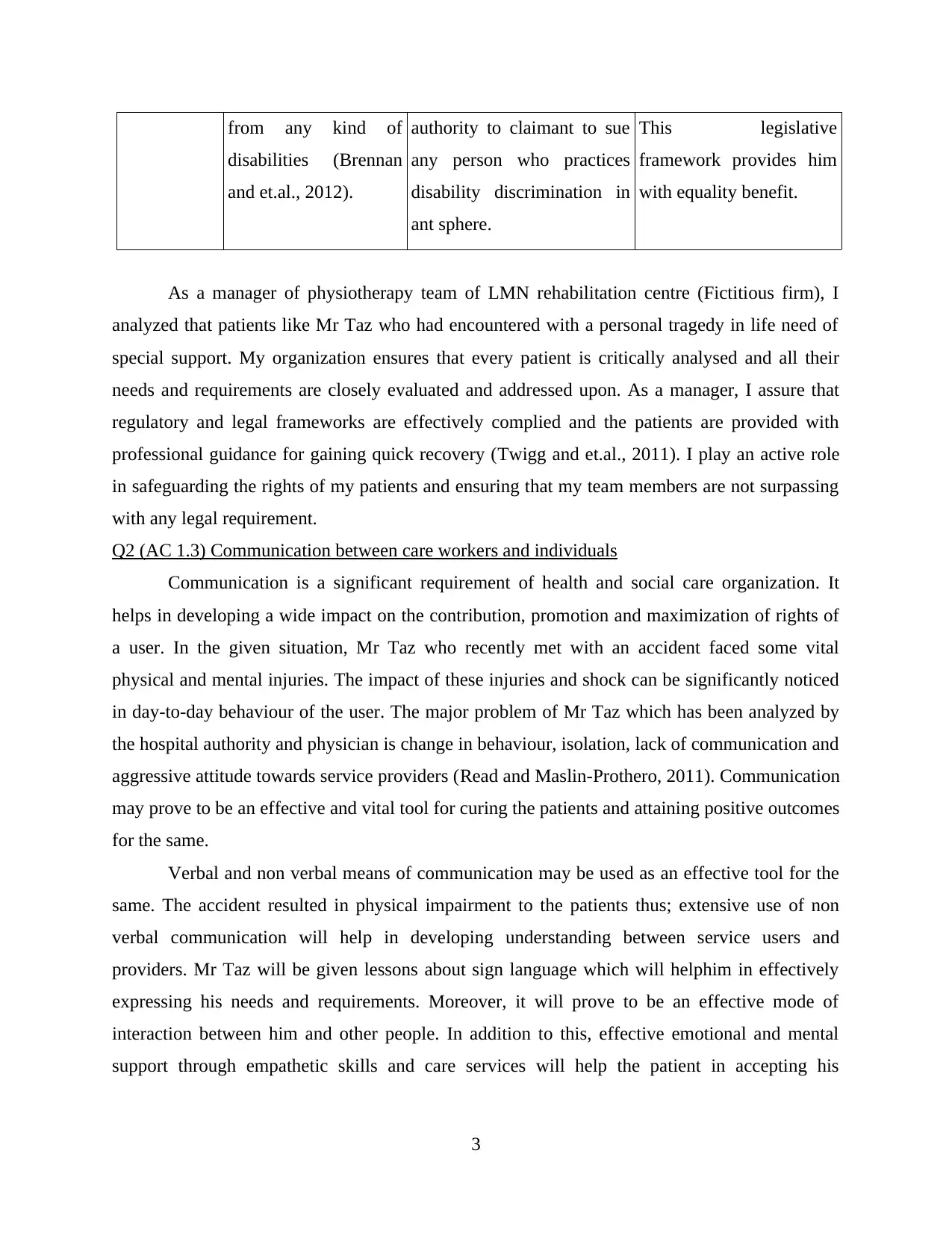
from any kind of
disabilities (Brennan
and et.al., 2012).
authority to claimant to sue
any person who practices
disability discrimination in
ant sphere.
This legislative
framework provides him
with equality benefit.
As a manager of physiotherapy team of LMN rehabilitation centre (Fictitious firm), I
analyzed that patients like Mr Taz who had encountered with a personal tragedy in life need of
special support. My organization ensures that every patient is critically analysed and all their
needs and requirements are closely evaluated and addressed upon. As a manager, I assure that
regulatory and legal frameworks are effectively complied and the patients are provided with
professional guidance for gaining quick recovery (Twigg and et.al., 2011). I play an active role
in safeguarding the rights of my patients and ensuring that my team members are not surpassing
with any legal requirement.
Q2 (AC 1.3) Communication between care workers and individuals
Communication is a significant requirement of health and social care organization. It
helps in developing a wide impact on the contribution, promotion and maximization of rights of
a user. In the given situation, Mr Taz who recently met with an accident faced some vital
physical and mental injuries. The impact of these injuries and shock can be significantly noticed
in day-to-day behaviour of the user. The major problem of Mr Taz which has been analyzed by
the hospital authority and physician is change in behaviour, isolation, lack of communication and
aggressive attitude towards service providers (Read and Maslin-Prothero, 2011). Communication
may prove to be an effective and vital tool for curing the patients and attaining positive outcomes
for the same.
Verbal and non verbal means of communication may be used as an effective tool for the
same. The accident resulted in physical impairment to the patients thus; extensive use of non
verbal communication will help in developing understanding between service users and
providers. Mr Taz will be given lessons about sign language which will helphim in effectively
expressing his needs and requirements. Moreover, it will prove to be an effective mode of
interaction between him and other people. In addition to this, effective emotional and mental
support through empathetic skills and care services will help the patient in accepting his
3
disabilities (Brennan
and et.al., 2012).
authority to claimant to sue
any person who practices
disability discrimination in
ant sphere.
This legislative
framework provides him
with equality benefit.
As a manager of physiotherapy team of LMN rehabilitation centre (Fictitious firm), I
analyzed that patients like Mr Taz who had encountered with a personal tragedy in life need of
special support. My organization ensures that every patient is critically analysed and all their
needs and requirements are closely evaluated and addressed upon. As a manager, I assure that
regulatory and legal frameworks are effectively complied and the patients are provided with
professional guidance for gaining quick recovery (Twigg and et.al., 2011). I play an active role
in safeguarding the rights of my patients and ensuring that my team members are not surpassing
with any legal requirement.
Q2 (AC 1.3) Communication between care workers and individuals
Communication is a significant requirement of health and social care organization. It
helps in developing a wide impact on the contribution, promotion and maximization of rights of
a user. In the given situation, Mr Taz who recently met with an accident faced some vital
physical and mental injuries. The impact of these injuries and shock can be significantly noticed
in day-to-day behaviour of the user. The major problem of Mr Taz which has been analyzed by
the hospital authority and physician is change in behaviour, isolation, lack of communication and
aggressive attitude towards service providers (Read and Maslin-Prothero, 2011). Communication
may prove to be an effective and vital tool for curing the patients and attaining positive outcomes
for the same.
Verbal and non verbal means of communication may be used as an effective tool for the
same. The accident resulted in physical impairment to the patients thus; extensive use of non
verbal communication will help in developing understanding between service users and
providers. Mr Taz will be given lessons about sign language which will helphim in effectively
expressing his needs and requirements. Moreover, it will prove to be an effective mode of
interaction between him and other people. In addition to this, effective emotional and mental
support through empathetic skills and care services will help the patient in accepting his
3
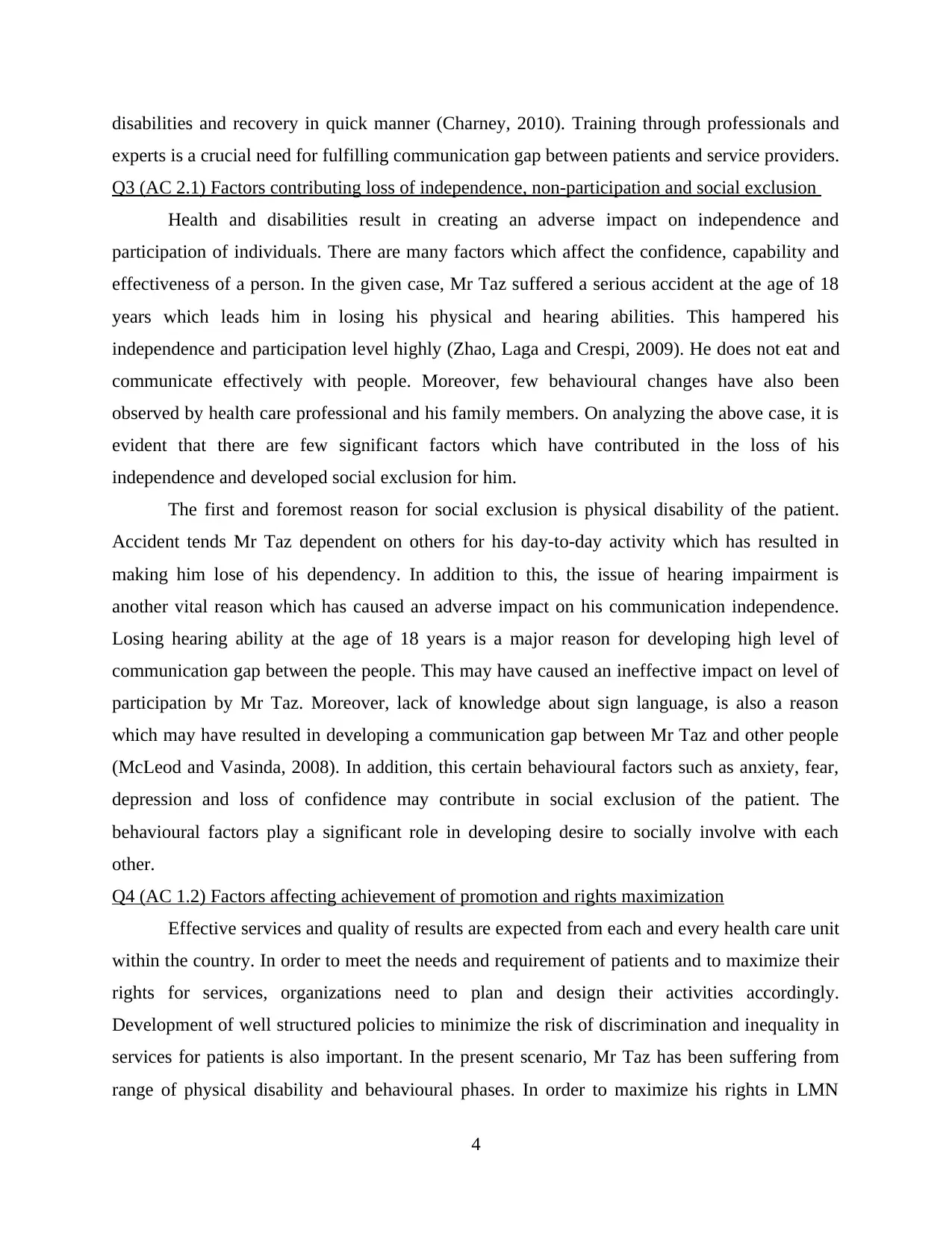
disabilities and recovery in quick manner (Charney, 2010). Training through professionals and
experts is a crucial need for fulfilling communication gap between patients and service providers.
Q3 (AC 2.1) Factors contributing loss of independence, non-participation and social exclusion
Health and disabilities result in creating an adverse impact on independence and
participation of individuals. There are many factors which affect the confidence, capability and
effectiveness of a person. In the given case, Mr Taz suffered a serious accident at the age of 18
years which leads him in losing his physical and hearing abilities. This hampered his
independence and participation level highly (Zhao, Laga and Crespi, 2009). He does not eat and
communicate effectively with people. Moreover, few behavioural changes have also been
observed by health care professional and his family members. On analyzing the above case, it is
evident that there are few significant factors which have contributed in the loss of his
independence and developed social exclusion for him.
The first and foremost reason for social exclusion is physical disability of the patient.
Accident tends Mr Taz dependent on others for his day-to-day activity which has resulted in
making him lose of his dependency. In addition to this, the issue of hearing impairment is
another vital reason which has caused an adverse impact on his communication independence.
Losing hearing ability at the age of 18 years is a major reason for developing high level of
communication gap between the people. This may have caused an ineffective impact on level of
participation by Mr Taz. Moreover, lack of knowledge about sign language, is also a reason
which may have resulted in developing a communication gap between Mr Taz and other people
(McLeod and Vasinda, 2008). In addition, this certain behavioural factors such as anxiety, fear,
depression and loss of confidence may contribute in social exclusion of the patient. The
behavioural factors play a significant role in developing desire to socially involve with each
other.
Q4 (AC 1.2) Factors affecting achievement of promotion and rights maximization
Effective services and quality of results are expected from each and every health care unit
within the country. In order to meet the needs and requirement of patients and to maximize their
rights for services, organizations need to plan and design their activities accordingly.
Development of well structured policies to minimize the risk of discrimination and inequality in
services for patients is also important. In the present scenario, Mr Taz has been suffering from
range of physical disability and behavioural phases. In order to maximize his rights in LMN
4
experts is a crucial need for fulfilling communication gap between patients and service providers.
Q3 (AC 2.1) Factors contributing loss of independence, non-participation and social exclusion
Health and disabilities result in creating an adverse impact on independence and
participation of individuals. There are many factors which affect the confidence, capability and
effectiveness of a person. In the given case, Mr Taz suffered a serious accident at the age of 18
years which leads him in losing his physical and hearing abilities. This hampered his
independence and participation level highly (Zhao, Laga and Crespi, 2009). He does not eat and
communicate effectively with people. Moreover, few behavioural changes have also been
observed by health care professional and his family members. On analyzing the above case, it is
evident that there are few significant factors which have contributed in the loss of his
independence and developed social exclusion for him.
The first and foremost reason for social exclusion is physical disability of the patient.
Accident tends Mr Taz dependent on others for his day-to-day activity which has resulted in
making him lose of his dependency. In addition to this, the issue of hearing impairment is
another vital reason which has caused an adverse impact on his communication independence.
Losing hearing ability at the age of 18 years is a major reason for developing high level of
communication gap between the people. This may have caused an ineffective impact on level of
participation by Mr Taz. Moreover, lack of knowledge about sign language, is also a reason
which may have resulted in developing a communication gap between Mr Taz and other people
(McLeod and Vasinda, 2008). In addition, this certain behavioural factors such as anxiety, fear,
depression and loss of confidence may contribute in social exclusion of the patient. The
behavioural factors play a significant role in developing desire to socially involve with each
other.
Q4 (AC 1.2) Factors affecting achievement of promotion and rights maximization
Effective services and quality of results are expected from each and every health care unit
within the country. In order to meet the needs and requirement of patients and to maximize their
rights for services, organizations need to plan and design their activities accordingly.
Development of well structured policies to minimize the risk of discrimination and inequality in
services for patients is also important. In the present scenario, Mr Taz has been suffering from
range of physical disability and behavioural phases. In order to maximize his rights in LMN
4
⊘ This is a preview!⊘
Do you want full access?
Subscribe today to unlock all pages.

Trusted by 1+ million students worldwide
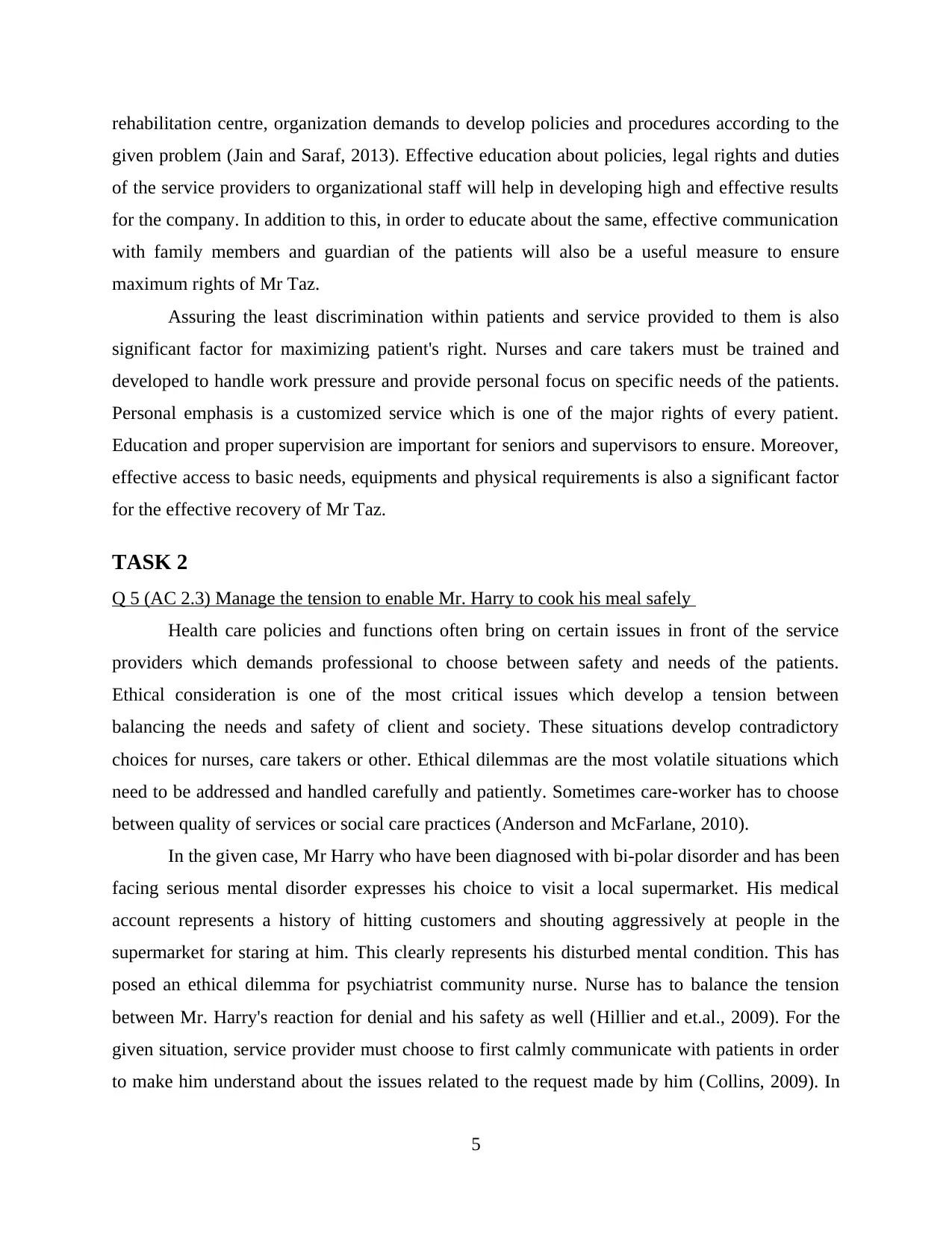
rehabilitation centre, organization demands to develop policies and procedures according to the
given problem (Jain and Saraf, 2013). Effective education about policies, legal rights and duties
of the service providers to organizational staff will help in developing high and effective results
for the company. In addition to this, in order to educate about the same, effective communication
with family members and guardian of the patients will also be a useful measure to ensure
maximum rights of Mr Taz.
Assuring the least discrimination within patients and service provided to them is also
significant factor for maximizing patient's right. Nurses and care takers must be trained and
developed to handle work pressure and provide personal focus on specific needs of the patients.
Personal emphasis is a customized service which is one of the major rights of every patient.
Education and proper supervision are important for seniors and supervisors to ensure. Moreover,
effective access to basic needs, equipments and physical requirements is also a significant factor
for the effective recovery of Mr Taz.
TASK 2
Q 5 (AC 2.3) Manage the tension to enable Mr. Harry to cook his meal safely
Health care policies and functions often bring on certain issues in front of the service
providers which demands professional to choose between safety and needs of the patients.
Ethical consideration is one of the most critical issues which develop a tension between
balancing the needs and safety of client and society. These situations develop contradictory
choices for nurses, care takers or other. Ethical dilemmas are the most volatile situations which
need to be addressed and handled carefully and patiently. Sometimes care-worker has to choose
between quality of services or social care practices (Anderson and McFarlane, 2010).
In the given case, Mr Harry who have been diagnosed with bi-polar disorder and has been
facing serious mental disorder expresses his choice to visit a local supermarket. His medical
account represents a history of hitting customers and shouting aggressively at people in the
supermarket for staring at him. This clearly represents his disturbed mental condition. This has
posed an ethical dilemma for psychiatrist community nurse. Nurse has to balance the tension
between Mr. Harry's reaction for denial and his safety as well (Hillier and et.al., 2009). For the
given situation, service provider must choose to first calmly communicate with patients in order
to make him understand about the issues related to the request made by him (Collins, 2009). In
5
given problem (Jain and Saraf, 2013). Effective education about policies, legal rights and duties
of the service providers to organizational staff will help in developing high and effective results
for the company. In addition to this, in order to educate about the same, effective communication
with family members and guardian of the patients will also be a useful measure to ensure
maximum rights of Mr Taz.
Assuring the least discrimination within patients and service provided to them is also
significant factor for maximizing patient's right. Nurses and care takers must be trained and
developed to handle work pressure and provide personal focus on specific needs of the patients.
Personal emphasis is a customized service which is one of the major rights of every patient.
Education and proper supervision are important for seniors and supervisors to ensure. Moreover,
effective access to basic needs, equipments and physical requirements is also a significant factor
for the effective recovery of Mr Taz.
TASK 2
Q 5 (AC 2.3) Manage the tension to enable Mr. Harry to cook his meal safely
Health care policies and functions often bring on certain issues in front of the service
providers which demands professional to choose between safety and needs of the patients.
Ethical consideration is one of the most critical issues which develop a tension between
balancing the needs and safety of client and society. These situations develop contradictory
choices for nurses, care takers or other. Ethical dilemmas are the most volatile situations which
need to be addressed and handled carefully and patiently. Sometimes care-worker has to choose
between quality of services or social care practices (Anderson and McFarlane, 2010).
In the given case, Mr Harry who have been diagnosed with bi-polar disorder and has been
facing serious mental disorder expresses his choice to visit a local supermarket. His medical
account represents a history of hitting customers and shouting aggressively at people in the
supermarket for staring at him. This clearly represents his disturbed mental condition. This has
posed an ethical dilemma for psychiatrist community nurse. Nurse has to balance the tension
between Mr. Harry's reaction for denial and his safety as well (Hillier and et.al., 2009). For the
given situation, service provider must choose to first calmly communicate with patients in order
to make him understand about the issues related to the request made by him (Collins, 2009). In
5
Paraphrase This Document
Need a fresh take? Get an instant paraphrase of this document with our AI Paraphraser
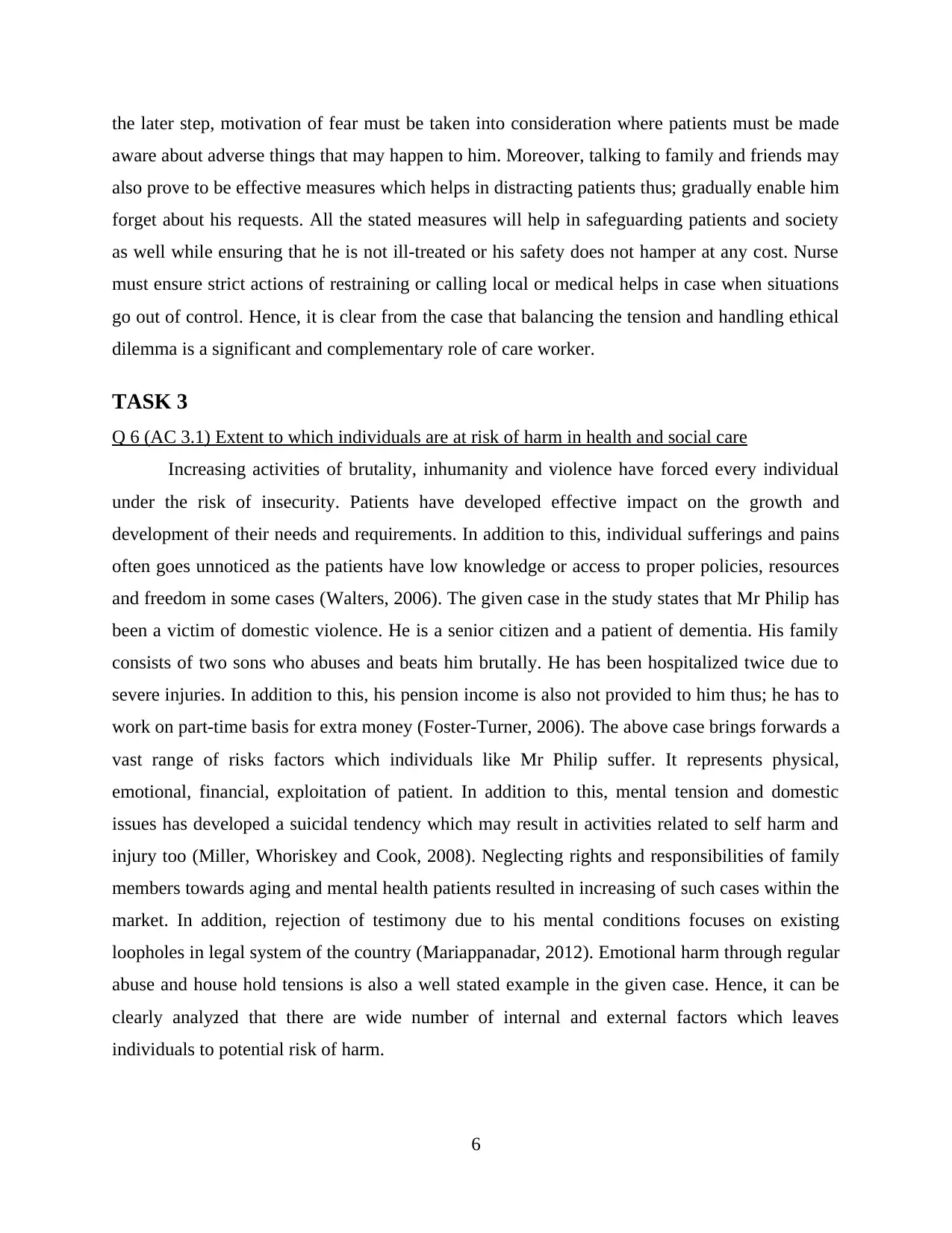
the later step, motivation of fear must be taken into consideration where patients must be made
aware about adverse things that may happen to him. Moreover, talking to family and friends may
also prove to be effective measures which helps in distracting patients thus; gradually enable him
forget about his requests. All the stated measures will help in safeguarding patients and society
as well while ensuring that he is not ill-treated or his safety does not hamper at any cost. Nurse
must ensure strict actions of restraining or calling local or medical helps in case when situations
go out of control. Hence, it is clear from the case that balancing the tension and handling ethical
dilemma is a significant and complementary role of care worker.
TASK 3
Q 6 (AC 3.1) Extent to which individuals are at risk of harm in health and social care
Increasing activities of brutality, inhumanity and violence have forced every individual
under the risk of insecurity. Patients have developed effective impact on the growth and
development of their needs and requirements. In addition to this, individual sufferings and pains
often goes unnoticed as the patients have low knowledge or access to proper policies, resources
and freedom in some cases (Walters, 2006). The given case in the study states that Mr Philip has
been a victim of domestic violence. He is a senior citizen and a patient of dementia. His family
consists of two sons who abuses and beats him brutally. He has been hospitalized twice due to
severe injuries. In addition to this, his pension income is also not provided to him thus; he has to
work on part-time basis for extra money (Foster-Turner, 2006). The above case brings forwards a
vast range of risks factors which individuals like Mr Philip suffer. It represents physical,
emotional, financial, exploitation of patient. In addition to this, mental tension and domestic
issues has developed a suicidal tendency which may result in activities related to self harm and
injury too (Miller, Whoriskey and Cook, 2008). Neglecting rights and responsibilities of family
members towards aging and mental health patients resulted in increasing of such cases within the
market. In addition, rejection of testimony due to his mental conditions focuses on existing
loopholes in legal system of the country (Mariappanadar, 2012). Emotional harm through regular
abuse and house hold tensions is also a well stated example in the given case. Hence, it can be
clearly analyzed that there are wide number of internal and external factors which leaves
individuals to potential risk of harm.
6
aware about adverse things that may happen to him. Moreover, talking to family and friends may
also prove to be effective measures which helps in distracting patients thus; gradually enable him
forget about his requests. All the stated measures will help in safeguarding patients and society
as well while ensuring that he is not ill-treated or his safety does not hamper at any cost. Nurse
must ensure strict actions of restraining or calling local or medical helps in case when situations
go out of control. Hence, it is clear from the case that balancing the tension and handling ethical
dilemma is a significant and complementary role of care worker.
TASK 3
Q 6 (AC 3.1) Extent to which individuals are at risk of harm in health and social care
Increasing activities of brutality, inhumanity and violence have forced every individual
under the risk of insecurity. Patients have developed effective impact on the growth and
development of their needs and requirements. In addition to this, individual sufferings and pains
often goes unnoticed as the patients have low knowledge or access to proper policies, resources
and freedom in some cases (Walters, 2006). The given case in the study states that Mr Philip has
been a victim of domestic violence. He is a senior citizen and a patient of dementia. His family
consists of two sons who abuses and beats him brutally. He has been hospitalized twice due to
severe injuries. In addition to this, his pension income is also not provided to him thus; he has to
work on part-time basis for extra money (Foster-Turner, 2006). The above case brings forwards a
vast range of risks factors which individuals like Mr Philip suffer. It represents physical,
emotional, financial, exploitation of patient. In addition to this, mental tension and domestic
issues has developed a suicidal tendency which may result in activities related to self harm and
injury too (Miller, Whoriskey and Cook, 2008). Neglecting rights and responsibilities of family
members towards aging and mental health patients resulted in increasing of such cases within the
market. In addition, rejection of testimony due to his mental conditions focuses on existing
loopholes in legal system of the country (Mariappanadar, 2012). Emotional harm through regular
abuse and house hold tensions is also a well stated example in the given case. Hence, it can be
clearly analyzed that there are wide number of internal and external factors which leaves
individuals to potential risk of harm.
6
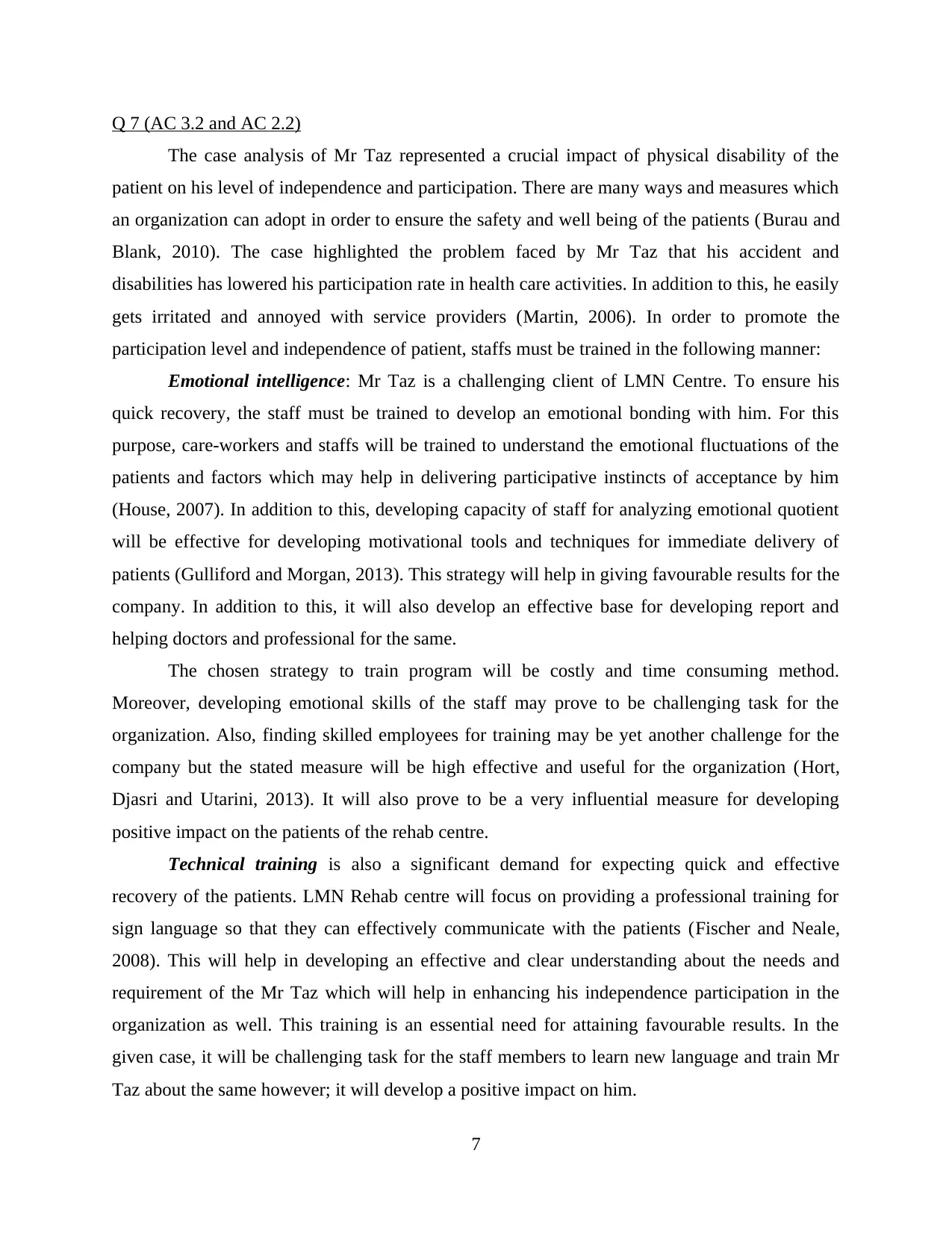
Q 7 (AC 3.2 and AC 2.2)
The case analysis of Mr Taz represented a crucial impact of physical disability of the
patient on his level of independence and participation. There are many ways and measures which
an organization can adopt in order to ensure the safety and well being of the patients (Burau and
Blank, 2010). The case highlighted the problem faced by Mr Taz that his accident and
disabilities has lowered his participation rate in health care activities. In addition to this, he easily
gets irritated and annoyed with service providers (Martin, 2006). In order to promote the
participation level and independence of patient, staffs must be trained in the following manner:
Emotional intelligence: Mr Taz is a challenging client of LMN Centre. To ensure his
quick recovery, the staff must be trained to develop an emotional bonding with him. For this
purpose, care-workers and staffs will be trained to understand the emotional fluctuations of the
patients and factors which may help in delivering participative instincts of acceptance by him
(House, 2007). In addition to this, developing capacity of staff for analyzing emotional quotient
will be effective for developing motivational tools and techniques for immediate delivery of
patients (Gulliford and Morgan, 2013). This strategy will help in giving favourable results for the
company. In addition to this, it will also develop an effective base for developing report and
helping doctors and professional for the same.
The chosen strategy to train program will be costly and time consuming method.
Moreover, developing emotional skills of the staff may prove to be challenging task for the
organization. Also, finding skilled employees for training may be yet another challenge for the
company but the stated measure will be high effective and useful for the organization (Hort,
Djasri and Utarini, 2013). It will also prove to be a very influential measure for developing
positive impact on the patients of the rehab centre.
Technical training is also a significant demand for expecting quick and effective
recovery of the patients. LMN Rehab centre will focus on providing a professional training for
sign language so that they can effectively communicate with the patients (Fischer and Neale,
2008). This will help in developing an effective and clear understanding about the needs and
requirement of the Mr Taz which will help in enhancing his independence participation in the
organization as well. This training is an essential need for attaining favourable results. In the
given case, it will be challenging task for the staff members to learn new language and train Mr
Taz about the same however; it will develop a positive impact on him.
7
The case analysis of Mr Taz represented a crucial impact of physical disability of the
patient on his level of independence and participation. There are many ways and measures which
an organization can adopt in order to ensure the safety and well being of the patients (Burau and
Blank, 2010). The case highlighted the problem faced by Mr Taz that his accident and
disabilities has lowered his participation rate in health care activities. In addition to this, he easily
gets irritated and annoyed with service providers (Martin, 2006). In order to promote the
participation level and independence of patient, staffs must be trained in the following manner:
Emotional intelligence: Mr Taz is a challenging client of LMN Centre. To ensure his
quick recovery, the staff must be trained to develop an emotional bonding with him. For this
purpose, care-workers and staffs will be trained to understand the emotional fluctuations of the
patients and factors which may help in delivering participative instincts of acceptance by him
(House, 2007). In addition to this, developing capacity of staff for analyzing emotional quotient
will be effective for developing motivational tools and techniques for immediate delivery of
patients (Gulliford and Morgan, 2013). This strategy will help in giving favourable results for the
company. In addition to this, it will also develop an effective base for developing report and
helping doctors and professional for the same.
The chosen strategy to train program will be costly and time consuming method.
Moreover, developing emotional skills of the staff may prove to be challenging task for the
organization. Also, finding skilled employees for training may be yet another challenge for the
company but the stated measure will be high effective and useful for the organization (Hort,
Djasri and Utarini, 2013). It will also prove to be a very influential measure for developing
positive impact on the patients of the rehab centre.
Technical training is also a significant demand for expecting quick and effective
recovery of the patients. LMN Rehab centre will focus on providing a professional training for
sign language so that they can effectively communicate with the patients (Fischer and Neale,
2008). This will help in developing an effective and clear understanding about the needs and
requirement of the Mr Taz which will help in enhancing his independence participation in the
organization as well. This training is an essential need for attaining favourable results. In the
given case, it will be challenging task for the staff members to learn new language and train Mr
Taz about the same however; it will develop a positive impact on him.
7
⊘ This is a preview!⊘
Do you want full access?
Subscribe today to unlock all pages.

Trusted by 1+ million students worldwide
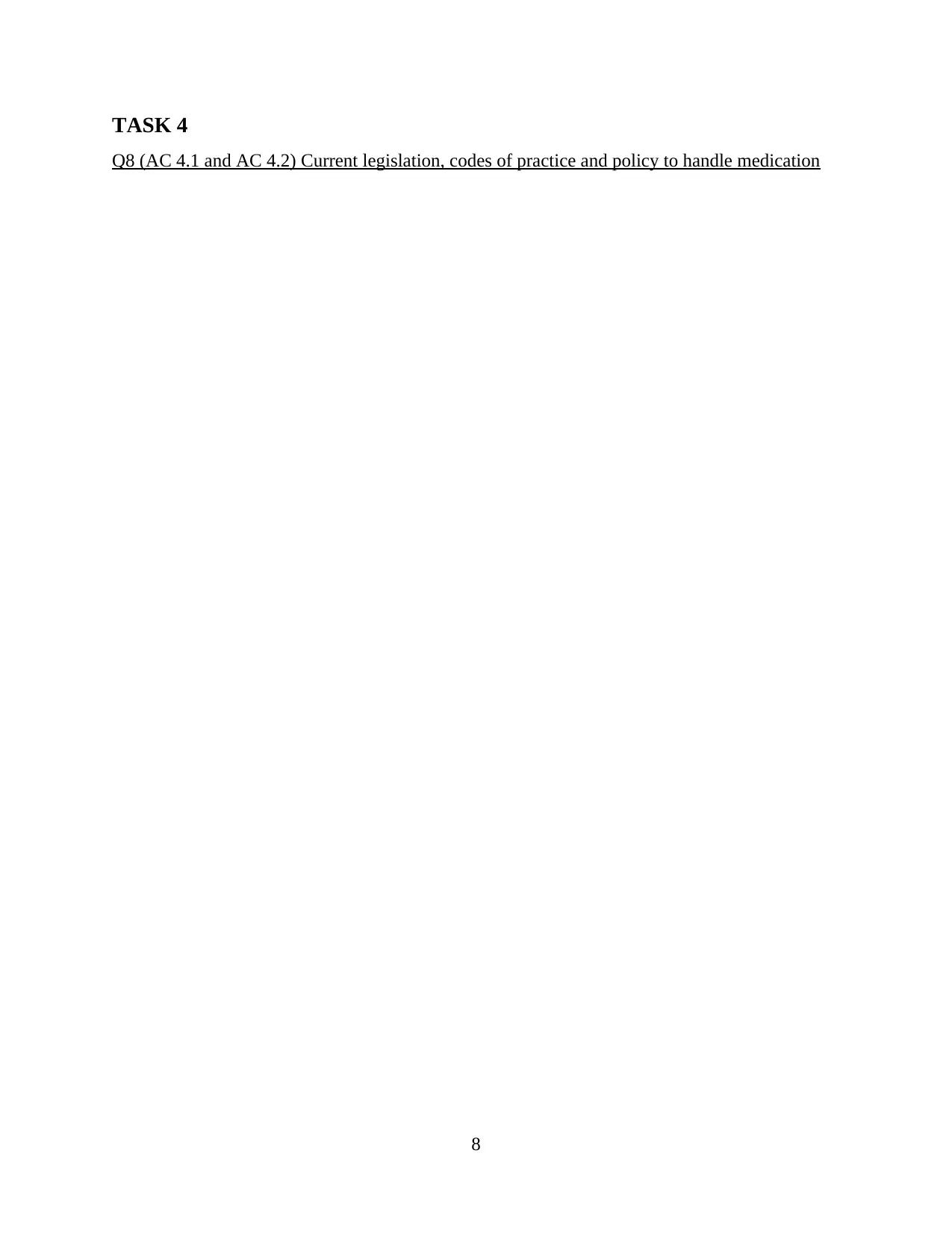
TASK 4
Q8 (AC 4.1 and AC 4.2) Current legislation, codes of practice and policy to handle medication
8
Q8 (AC 4.1 and AC 4.2) Current legislation, codes of practice and policy to handle medication
8
Paraphrase This Document
Need a fresh take? Get an instant paraphrase of this document with our AI Paraphraser
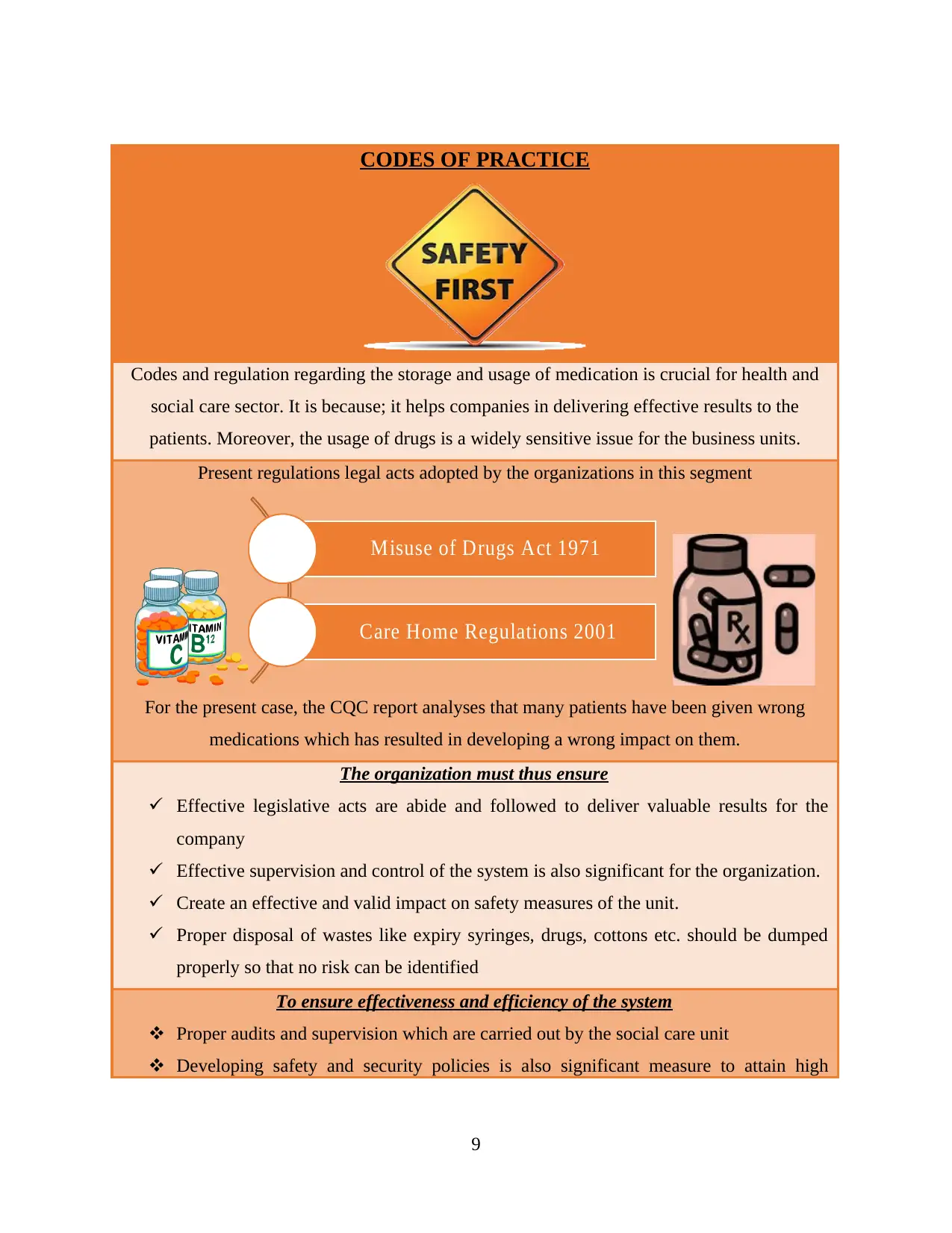
CODES OF PRACTICE
Codes and regulation regarding the storage and usage of medication is crucial for health and
social care sector. It is because; it helps companies in delivering effective results to the
patients. Moreover, the usage of drugs is a widely sensitive issue for the business units.
Present regulations legal acts adopted by the organizations in this segment
For the present case, the CQC report analyses that many patients have been given wrong
medications which has resulted in developing a wrong impact on them.
The organization must thus ensure
Effective legislative acts are abide and followed to deliver valuable results for the
company
Effective supervision and control of the system is also significant for the organization.
Create an effective and valid impact on safety measures of the unit.
Proper disposal of wastes like expiry syringes, drugs, cottons etc. should be dumped
properly so that no risk can be identified
To ensure effectiveness and efficiency of the system
Proper audits and supervision which are carried out by the social care unit
Developing safety and security policies is also significant measure to attain high
9
Misuse of Drugs Act 1971
Care Home Regulations 2001
Codes and regulation regarding the storage and usage of medication is crucial for health and
social care sector. It is because; it helps companies in delivering effective results to the
patients. Moreover, the usage of drugs is a widely sensitive issue for the business units.
Present regulations legal acts adopted by the organizations in this segment
For the present case, the CQC report analyses that many patients have been given wrong
medications which has resulted in developing a wrong impact on them.
The organization must thus ensure
Effective legislative acts are abide and followed to deliver valuable results for the
company
Effective supervision and control of the system is also significant for the organization.
Create an effective and valid impact on safety measures of the unit.
Proper disposal of wastes like expiry syringes, drugs, cottons etc. should be dumped
properly so that no risk can be identified
To ensure effectiveness and efficiency of the system
Proper audits and supervision which are carried out by the social care unit
Developing safety and security policies is also significant measure to attain high
9
Misuse of Drugs Act 1971
Care Home Regulations 2001
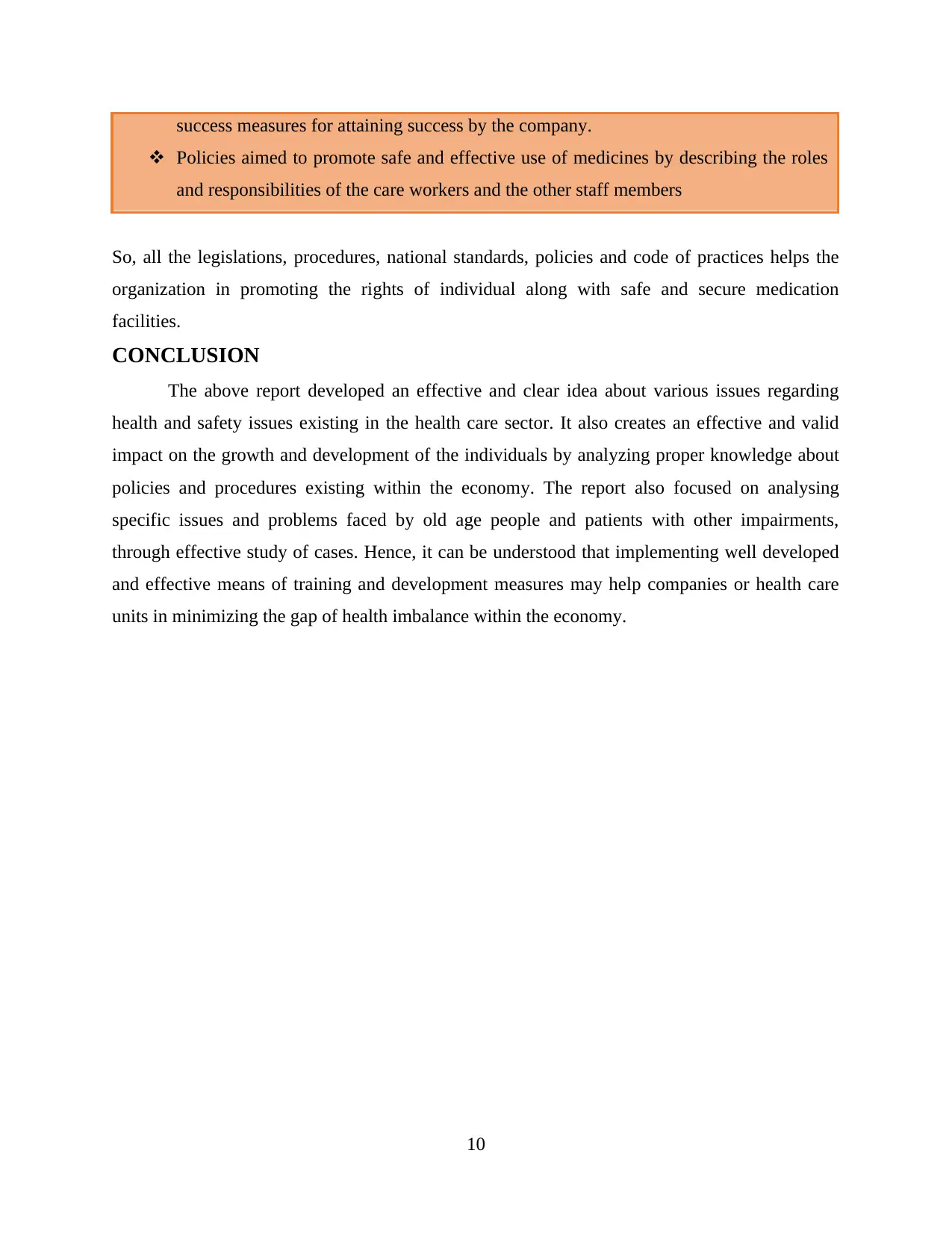
success measures for attaining success by the company.
Policies aimed to promote safe and effective use of medicines by describing the roles
and responsibilities of the care workers and the other staff members
So, all the legislations, procedures, national standards, policies and code of practices helps the
organization in promoting the rights of individual along with safe and secure medication
facilities.
CONCLUSION
The above report developed an effective and clear idea about various issues regarding
health and safety issues existing in the health care sector. It also creates an effective and valid
impact on the growth and development of the individuals by analyzing proper knowledge about
policies and procedures existing within the economy. The report also focused on analysing
specific issues and problems faced by old age people and patients with other impairments,
through effective study of cases. Hence, it can be understood that implementing well developed
and effective means of training and development measures may help companies or health care
units in minimizing the gap of health imbalance within the economy.
10
Policies aimed to promote safe and effective use of medicines by describing the roles
and responsibilities of the care workers and the other staff members
So, all the legislations, procedures, national standards, policies and code of practices helps the
organization in promoting the rights of individual along with safe and secure medication
facilities.
CONCLUSION
The above report developed an effective and clear idea about various issues regarding
health and safety issues existing in the health care sector. It also creates an effective and valid
impact on the growth and development of the individuals by analyzing proper knowledge about
policies and procedures existing within the economy. The report also focused on analysing
specific issues and problems faced by old age people and patients with other impairments,
through effective study of cases. Hence, it can be understood that implementing well developed
and effective means of training and development measures may help companies or health care
units in minimizing the gap of health imbalance within the economy.
10
⊘ This is a preview!⊘
Do you want full access?
Subscribe today to unlock all pages.

Trusted by 1+ million students worldwide
1 out of 15
Related Documents
Your All-in-One AI-Powered Toolkit for Academic Success.
+13062052269
info@desklib.com
Available 24*7 on WhatsApp / Email
![[object Object]](/_next/static/media/star-bottom.7253800d.svg)
Unlock your academic potential
Copyright © 2020–2025 A2Z Services. All Rights Reserved. Developed and managed by ZUCOL.





